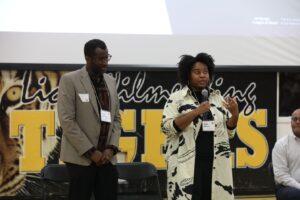Joy as resistance, play as healing and rest as resilience. On Friday January 12, Lick-Wilmerding High School students, faculty and staff were guided by these themes in commemorating and celebrating the life of Rev. Dr. Martin Luther King Jr.
The inaugural MLK Day event attempted to address issues facing the LWHS community, like stress and academic burnout, while simultaneously serving as an educational forum for Dr. King’s legacy. The event’s activities included keynote speeches, workshops and bonding activities.
The celebration was spearheaded by LWHS’s Dean of Equity and Inclusion, Dee Johnson and Director of Student Inclusion Matthew Oakland. Oakland, who joined the LWHS community this past fall, led a similar MLK event at his previous institution, The Nueva School. When brainstorming events for this year, he knew he wanted to introduce something similar at LWHS. “When [we] saw that there wasn’t an event to formally hold space for [MLK Day] Dee and I were like, ‘this is a great opportunity,’” Oakland said.
Throughout the day, students were encouraged to center themes of joy, rest and play through a variety of practices. One workshop that highlighted the importance of relaxation was the “Sound Bath,” led by Tech Arts teacher Samu Cortez. Cortez, inspired by their own practices to reconnect with their Indigenous identity, had students relax or meditate while listening to sounds at distinct frequencies. “A lot of times we are in this grind of ‘go go go’… [but] for me, joy is just as important,” Cortez said.

photo courtesy of Vidigami
The BIPOC Healing Space led by History teacher, René Villicaña, focused on themes of joy and reflection. “I loved seeing students slowly settle into the experience, gradually open up more and share their truths,” Villicaña said. “I hope students felt seen, heard, valued, appreciated, held and cared for.”
Several months ago, a racial epithet was repeatedly transcribed on a bathroom stall. The hate speech incident brought up feelings of pain for many students, and many found Villicaña’s space to be a necessary response. “I would say my favorite part of [MLK Day] was probably the affinity space,” Sienna Waldron ’25 said. Waldron connected the vital presence of affinity spaces at community events to the incident itself. “During the hate speech on campus [incident]… having a Black affinity space was really helpful,” she said.
The day also included a variety of workshops that focused on the theme of joy, such as “Music as Joy and Resistance: The Music of Max Roach, Abby Lincoln and Sonny Rollins during the Civil Rights Movement,” and “Spreading Joy through Living Color: The Flower Fairy Festivities.”
Facilities staff member, Maurice Williams, led a workshop centered around play, specifically through the medium of music. His workshop, titled “Groove & Frequency,” instructed students to collaborate in creating an electronic beat. Williams wanted to show students how music can be therapeutic. “I would truly appreciate having a continuous program in place as I am deeply aware of the stress levels many students endure. Offering them the opportunity to access the music room regularly and engage with live and digital instruments can serve as a significant stress-relief outlet,” he said.
These workshops, along with many others, allowed students to engage with the celebration’s themes through a wide range of approaches.
Although relatively positive themes were a guiding force for the event, there were also areas that brought attention to Black pain and cycles of oppression. The morning keynote speech primarily discussed last year’s Kehinde Wiley exhibit, “An Archaeology of Silence,” that was shown at the de Young Museum in San Francisco. The exhibit showed works that portray Black figures in positions of rest or death; Wiley intended for the exhibition to draw attention to the systemic violence faced by the Black community.

photo courtesy of Vidigami
The keynote speakers, Devin Malone and Abram Jackson, were central in curating the exhibit. Malone currently serves as director of public programs and community engagement at the Fine Arts Museums of San Francisco, and Jackson is the de Young’s first Director of Interpretation. During their presentation, Malone and Jackson discussed the tragic themes of the exhibit, which juxtaposed the persistent messages of hope and change.
Malone connected the exhibit to King’s legacy through their similar political undertones. “[Dr. King] was a much more radical figure than people give him credit for…much like him, there are these complex political registers throughout the exhibition,” they said. Jackson hopes that viewers of the exhibit, young people especially, see it as a call to action. “We hoped that people would go to the exhibition, see it, experience it and try to do something to dismantle systemic violence,” he said.
Additionally, over the course of the celebration, the LWHS community found more informal ways to connect. The community breakfast held that morning, for example, allowed students to enjoy breakfast foods while participating in guided discussions about the event’s themes. Similarly, during lunch, many community members participated in an impromptu dance performance with the Afro-Latinx dance company Loco Bloco.
The closing keynote speech by adrienne maree brown concluded the day with a message of hope. brown is an author and activist whose 2017 novel “Emergent Strategy: Shaping Change, Changing Worlds” is one of the guiding texts for LWHS’s Ethnic Studies course. In her keynote, brown spoke to the radical powers of rest, resilience and joy, and the importance of embracing community strength rather than division.
Students of all grades expressed feelings of happiness and fun attached to the event. “My first workshop [was] with the keynote speakers…it was an incredible experience,” Chelsie Joy Valerio ’25 said. Dylan Lachance ’27 said the day changed his perspective on what resistance can look like. “Resistance doesn’t necessarily have to be active, even something as simple as rest can be just as impactful,” he said.
Oakland hopes that this event is something that will become an annual tradition for the LWHS community. “The best part for me is that [the event is] for sure going to be done in future years. Even if 50 years from now this school looks different, I’m hoping MLK Day is having its 51st anniversary,” they said.






